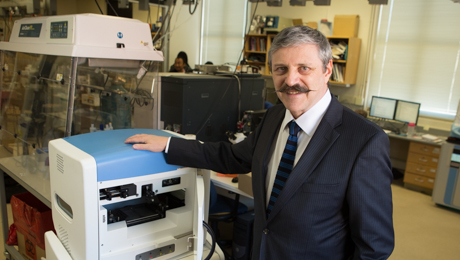Contaminants that are billions of times smaller than a speck of dust can poison our environment, our food and our bodies. Even with the most state-of-the-art analysis tools, the tiniest traces often remain undetected.
Now those invisible threats can no longer hide, thanks to a new technology developed by a George Washington University researcher.
Akos Vertes, a chemistry professor in the Columbian College of Arts and Sciences, has created a nano-device capable of rapidly identifying materials made up of as little as 100,000 molecules.
“We’re talking about a really, really, really minute amount of material,” Dr. Vertes said. “Sample sizes as small as a single yeast cell are sufficient for detailed analysis.”
The REDIchip (Resonance-Enhanced Desorption Ionization) can fit into the palm of your hand and has wide-ranging applications, from drug development to early disease detection and chemical imaging. Funding for the research behind the project came from the U.S. Department of Energy and $14.6 million from the Defense Advanced Research Projects Agency (DARPA).
The biotechnology company Protea Biosciences, Inc., licensed and commercialized the REDIchip, which will be available on the market in July.
“Because this technology is capable of detecting such tiny amounts of material in a person’s urine, saliva or blood, we may have an early indication that someone will develop diabetes or heart disease, which could be hard to find through traditional diagnostics,” Dr. Vertes said.

The REDIchip can analyze minute amounts of biological and chemical materials. After placing a sample directly on the chip, a mass spectrometer measures the ions that are produced to determine the composition of the substance. (William Atkins/GW Today)
The miniature chip can also be used to analyze hazardous chemicals in the environment, like endocrine disruptors that can alter normal hormone levels, and detect potential chemical or biological threats. It can also help scientists study how those threats might affect humans.
“We could, for example, expose human cells to a new agent and quickly determine what kind of changes occur in the small molecules of the cell,” Dr. Vertes said. “This is very important if you want to develop protection against it.”
Unlike other technologies that can detect single molecules, the REDIchip is capable of non-targeted analysis. That means that researchers do not need to know the specific molecule they are searching for in any given sample. Instead, they can drop liquid or a tissue sample directly on to the device and receive an inventory of the many different materials that are present.
The REDIchip is made of silicon and has rows of disks that reflect light bright neon colors, each consisting of around two million miniscule dots that are 150 nanometers wide—about 500 times smaller than the width of a human hair. After placing the sample on the chip, the researchers put the device into a mass spectrometer. The instrument has a laser that heats up the chips’ small disks and converts them into ions. Finally, the mass spectrometer measures and identifies the ions.
What makes the REDIchip especially unique is that it does not require any external materials or additives—known as a matrix—that can interfere with molecule detection. This is what allows the REDIchip to recognize and analyze such small amounts of materials.
“The problem is that when there is a matrix, which is a small molecule itself, the ions of the other small molecules that you are trying to detect are suppressed and obscured,” Dr. Vertes said. “With our technology, we can avoid all of that. The substrate is what absorbs the laser light instead of a matrix.”
The REDIchip also can perform chemical imaging. In their research, Dr. Vertes and his team were able to section a mouse brain and use the REDIchip to view exactly where particular molecules were distributed. This is a useful tool for drug developers, because, when testing a drug candidate, they want to ensure that the drug ends up in the intended locations of the brain or body.
This capability also has implications for locating cancer tumors, according to Dr. Vertes.
“Let’s say you have a tissue section and there are some cancerous lesions, and you want to identify the metabolic composition inside and outside of the lesion,” he said. “When a surgeon is cutting cancer tissue, the big question is always, how much to cut? I believe our technology can give more accurate, detailed information about tumor margins.”
Currently, Dr. Vertes believes the REDIchip will be sold primarily to researchers, pharmaceutical companies and government agencies. Though the technology is hand-held, the needed mass spectrometry equipment is still too expensive and requires a specialist to be readily available in a doctor’s office.
“That change may come when there is such a compelling advantage from a medical point of view,” Dr. Vertes said, “that doctors would say, ‘No matter how expensive, we have to have this.’”



